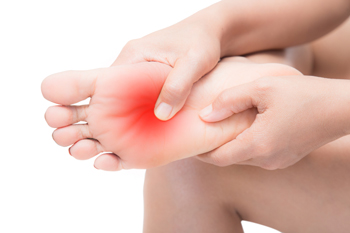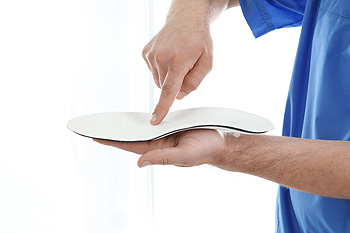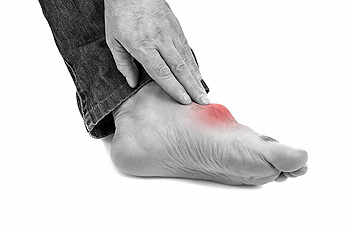Items filtered by date: March 2020
Standing for Most of the Day May Cause Foot Pain
 Patients who work while standing on hard surfaces for most of the day may be familiar with general foot pain. It is beneficial to wear shoes that fit correctly, as this may be helpful in reducing existing foot discomfort. Additionally, some patients will choose to wear insoles in their shoes which can help to add extra comfort and support. Compression socks may be helpful in circulating blood flow through the feet, and this can make it easier to stand during the day. There are also specific foot stretches that can be performed while standing that can help the feet to feel better. These stretches can consist of rolling the arch of your foot on a tennis ball, and pointing and flexing your foot as often as possible. If you would like more information about finding comfort while standing during the day, please consult with your local podiatrist.
Patients who work while standing on hard surfaces for most of the day may be familiar with general foot pain. It is beneficial to wear shoes that fit correctly, as this may be helpful in reducing existing foot discomfort. Additionally, some patients will choose to wear insoles in their shoes which can help to add extra comfort and support. Compression socks may be helpful in circulating blood flow through the feet, and this can make it easier to stand during the day. There are also specific foot stretches that can be performed while standing that can help the feet to feel better. These stretches can consist of rolling the arch of your foot on a tennis ball, and pointing and flexing your foot as often as possible. If you would like more information about finding comfort while standing during the day, please consult with your local podiatrist.
While working on the feet, it is important to take the proper care of them. For more information about working on your feet, contact Dr. John P. Beaupied from Palos Podiatry. Our doctor will treat your foot and ankle needs.
Working on Your Feet
Standing on your feet for long periods of time can cause stress and pain in your feet. Your whole body may experience change in terms of posture, back pain, bunions, callouses and or plantar warts. There are ways to avoid these conditions with proper foot care, smart choices and correct posture.
Positive Changes
Negative heeled shoe – Choosing this shoe type places the heel slightly lower than the ball of the foot. These are great for overall foot health. Find shoes that fit you correctly.
Go barefoot – Our feet were not designed to be enclosed for all hours of the day. Try to periodically expose your feet to air.
Eliminate Pain
Foot Exercises – Performing simple exercises, incorporating yoga and doing stretches are beneficial. This will allow increased blood flow to the area and muscles of the foot.
Achilles tendon – Stretching the foot out flat on the floor will relax the calf muscles and tendon. These exercises can be performed almost anywhere. Make sure you add these exercises to your daily regimen.
With a little bit of this information and knowing more about foot health, you will notice changes. Foot stretches and proper footwear will help with pain and prevent further issues.
If you have any questions please feel free to contact our office located in Palos Heights, IL . We offer the newest diagnostic and treatment technologies for all your foot and ankle needs.
What Symptoms are Indicative of Morton’s Neuroma?
 One common cause of Morton’s neuroma includes wearing footwear that is too tight for your feet. This condition may occur when a nerve between the toes becomes pinched and inflamed, often causing a numbing or tingling feeling in the affected foot. Some patients have also expressed it felt as if they were walking with a pebble in their shoe, as well as a burning felt in the forefoot. Along with ill fitting footwear, certain foot deformities may also be a factor in the development of Morton’s neuroma. Some conditions that increase your risk of developing a neuroma may include hammertoes and bunions. To help alleviate some of the discomfort associated with this condition, patients have found using insoles and custom orthotics to be quite helpful. If you believe you have developed Morton’s neuroma and would like more information on how to treat this condition, it is suggested that you speak with a podiatrist.
One common cause of Morton’s neuroma includes wearing footwear that is too tight for your feet. This condition may occur when a nerve between the toes becomes pinched and inflamed, often causing a numbing or tingling feeling in the affected foot. Some patients have also expressed it felt as if they were walking with a pebble in their shoe, as well as a burning felt in the forefoot. Along with ill fitting footwear, certain foot deformities may also be a factor in the development of Morton’s neuroma. Some conditions that increase your risk of developing a neuroma may include hammertoes and bunions. To help alleviate some of the discomfort associated with this condition, patients have found using insoles and custom orthotics to be quite helpful. If you believe you have developed Morton’s neuroma and would like more information on how to treat this condition, it is suggested that you speak with a podiatrist.
Morton’s neuroma is a very uncomfortable condition to live with. If you think you have Morton’s neuroma, contact Dr. John P. Beaupied of Palos Podiatry. Our doctor will attend to all of your foot care needs and answer any of your related questions.
Morton’s Neuroma
Morton's neuroma is a painful foot condition that commonly affects the areas between the second and third or third and fourth toe, although other areas of the foot are also susceptible. Morton’s neuroma is caused by an inflamed nerve in the foot that is being squeezed and aggravated by surrounding bones.
What Increases the Chances of Having Morton’s Neuroma?
- Ill-fitting high heels or shoes that add pressure to the toe or foot
- Jogging, running or any sport that involves constant impact to the foot
- Flat feet, bunions, and any other foot deformities
Morton’s neuroma is a very treatable condition. Orthotics and shoe inserts can often be used to alleviate the pain on the forefront of the feet. In more severe cases, corticosteroids can also be prescribed. In order to figure out the best treatment for your neuroma, it’s recommended to seek the care of a podiatrist who can diagnose your condition and provide different treatment options.
If you have any questions, please feel free to contact our office located in Palos Heights, IL . We offer the newest diagnostic and treatment technologies for all your foot care needs.
How Are Orthotics Made?
 Orthotics are known as insoles that fit inside shoes, which may help to provide the necessary support needed for specific foot conditions. They are custom designed for each patient, and the process begins with taking a plaster mold of the affected foot. The necessary adjustments can be made for size, as this will help the insole to fit perfectly inside the shoe. Some of the reasons why patients choose to wear orthotics may consist of correcting an abnormal walking pattern, or to relieve pressure in a portion of the foot. Additionally, orthotics may help to reduce chronic foot pain, as well as improve certain foot alignments. If you would like more information about custom-made orthotics, please consult with a podiatrist who can determine if they are right for you.
Orthotics are known as insoles that fit inside shoes, which may help to provide the necessary support needed for specific foot conditions. They are custom designed for each patient, and the process begins with taking a plaster mold of the affected foot. The necessary adjustments can be made for size, as this will help the insole to fit perfectly inside the shoe. Some of the reasons why patients choose to wear orthotics may consist of correcting an abnormal walking pattern, or to relieve pressure in a portion of the foot. Additionally, orthotics may help to reduce chronic foot pain, as well as improve certain foot alignments. If you would like more information about custom-made orthotics, please consult with a podiatrist who can determine if they are right for you.
If you are having discomfort in your feet and would like to try orthotics, contact Dr. John P. Beaupied from Palos Podiatry. Our doctor can provide the care you need to keep you pain-free and on your feet.
What Are Orthotics?
Orthotics are inserts you can place into your shoes to help with a variety of foot problems such as flat feet or foot pain. Orthotics provide relief and comfort for minor foot and heel pain but can’t correct serious biomechanical problems in your feet.
Over-the-Counter Inserts
Orthotics come in a wide variety of over-the-counter inserts that are used to treat foot pain, heel pain, and minor problems. For example, arch supports can be inserted into your shoes to help correct overarched or flat feet, while gel insoles are often used because they provide comfort and relief from foot and heel pain by alleviating pressure.
Prescription Orthotics
If over-the-counter inserts don’t work for you or if you have a more severe foot concern, it is possible to have your podiatrist prescribe custom orthotics. These high-quality inserts are designed to treat problems such as abnormal motion, plantar fasciitis, and severe forms of heel pain. They can even be used to help patients suffering from diabetes by treating foot ulcers and painful calluses and are usually molded to your feet individually, which allows them to provide full support and comfort.
If you are experiencing minor to severe foot or heel pain, it’s recommended to speak with your podiatrist about the possibilities of using orthotics. A podiatrist can determine which type of orthotic is right for you and allow you to take the first steps towards being pain-free.
If you have any questions please contact our office located in Palos Heights, IL . We offer the newest diagnostic and treatment technologies for all your foot and ankle needs.
Why Live with Pain and Numbness in Your Feet?
Signs You May Have Developed Gout
 Gout is a type of inflammatory arthritis that occurs when too much uric acid is found in the blood. When this uric acid progressively builds up, crystals form that attach to the joints and lead to pain, often felt in the foot or ankle region. This pain may also come in spurts, which is typically referred to as gout attacks. Redness and swelling of the feet, along with pain, and feeling slightly feverish, are all symptoms you may experience if you have developed gout. Because this condition can be incredibly painful, it’s recommended that you seek the care of a podiatrist who will be able to properly diagnose your condition, as well as offer you a means to alleviate your discomfort.
Gout is a type of inflammatory arthritis that occurs when too much uric acid is found in the blood. When this uric acid progressively builds up, crystals form that attach to the joints and lead to pain, often felt in the foot or ankle region. This pain may also come in spurts, which is typically referred to as gout attacks. Redness and swelling of the feet, along with pain, and feeling slightly feverish, are all symptoms you may experience if you have developed gout. Because this condition can be incredibly painful, it’s recommended that you seek the care of a podiatrist who will be able to properly diagnose your condition, as well as offer you a means to alleviate your discomfort.
Gout is a foot condition that requires certain treatment and care. If you are seeking treatment, contact Dr. John P. Beaupied from Palos Podiatry. Our doctor will treat your foot and ankle needs.
What Is Gout?
Gout is a type of arthritis caused by a buildup of uric acid in the bloodstream. It often develops in the foot, especially the big toe area, although it can manifest in other parts of the body as well. Gout can make walking and standing very painful and is especially common in diabetics and the obese.
People typically get gout because of a poor diet. Genetic predisposition is also a factor. The children of parents who have had gout frequently have a chance of developing it themselves.
Gout can easily be identified by redness and inflammation of the big toe and the surrounding areas of the foot. Other symptoms include extreme fatigue, joint pain, and running high fevers. Sometimes corticosteroid drugs can be prescribed to treat gout, but the best way to combat this disease is to get more exercise and eat a better diet.
If you have any questions please feel free to contact our office located in Palos Heights, IL . We offer the newest diagnostic and treatment technologies for all your foot and ankle needs.
The Function of the Sesamoid Bones
The sesamoid bones are located under the ball of the foot. They help to enable the big toe to press down, and pain and discomfort may develop if they should become inflamed. This may happen as a result of participating in running and jumping activities, or from wearing shoes that do not fit correctly. Common symptoms that can be associated with this ailment may include pain on the bottom of the foot, and it may be difficult to stand on your tiptoes. Patients who have this condition may find moderate relief when the affected foot is elevated, and it may help to use an insole that can support the arch. If you feel you may have sesamoiditis, it is strongly advised that you consult with a podiatrist who can properly diagnose and treat this condition.
Sesamoiditis is an unpleasant foot condition characterized by pain in the balls of the feet. If you think you’re struggling with sesamoiditis, contact Dr. John P. Beaupied of Palos Podiatry. Our doctor will treat your condition thoroughly and effectively.
Sesamoiditis
Sesamoiditis is a condition of the foot that affects the ball of the foot. It is more common in younger people than it is in older people. It can also occur with people who have begun a new exercise program, since their bodies are adjusting to the new physical regimen. Pain may also be caused by the inflammation of tendons surrounding the bones. It is important to seek treatment in its early stages because if you ignore the pain, this condition can lead to more serious problems such as severe irritation and bone fractures.
Causes of Sesamoiditis
- Sudden increase in activity
- Increase in physically strenuous movement without a proper warm up or build up
- Foot structure: those who have smaller, bonier feet or those with a high arch may be more susceptible
Treatment for sesamoiditis is non-invasive and simple. Doctors may recommend a strict rest period where the patient forgoes most physical activity. This will help give the patient time to heal their feet through limited activity. For serious cases, it is best to speak with your doctor to determine a treatment option that will help your specific needs.
If you have any questions please feel free to contact our office located in Palos Heights, IL . We offer the newest diagnostic and treatment technologies for all your foot and ankle needs.





